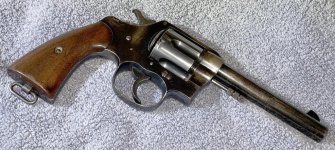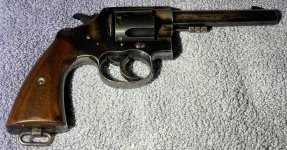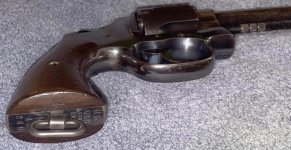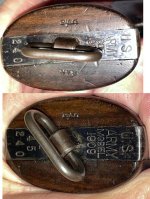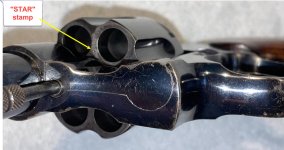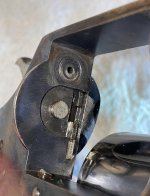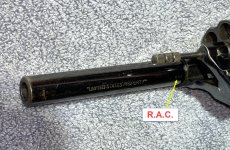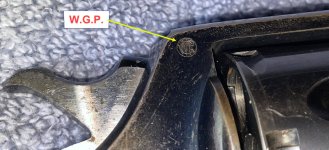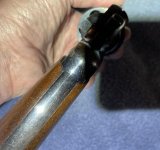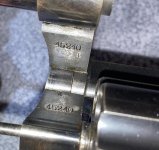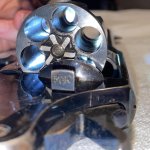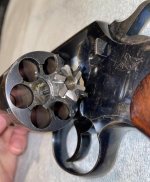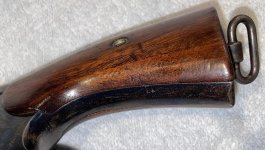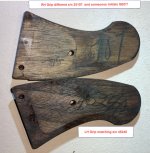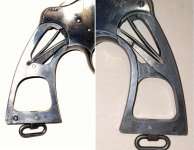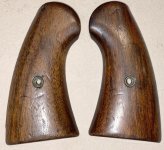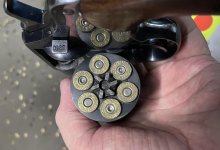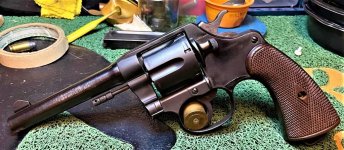When I bought this at a gun show a few months back, I was familiar what to look for on the S&W victory models plus PRE & POST. And The Colt and S&W 1917s. But I had never seen a Colt 1909 Army or read about this revolver.
I had been looking for a S&W Model 25-5 non-pinned since I'm fond of the 45 Colt Cartridge. So, when I saw this and the dealer said it was 45 Colt I knew if it functioned well, I would probably get it.
He's the one that told me that it has all the R.A.C. stamps, etc. and I wasn't familiar with those initials at the time. (I am now)
What little I have learned about revolvers in the last year I did make sure the cylinder revolved around on each chamber as I cocked it.
The finish is not great on the barrel. Strange the way it is worn with circular marks on left side of barrel. Not quite as bad as on right side.
I failed on first inspection to WONDER why the wear on the right side of frame and barrel didn't show that same wear on the CYLINDER.
After researching this last week on some great sites for this revolver I saw ALL the cylinders have R.A.C. stamped on aft side. So quickly looked at mine again and the R.A.C. is NOT there.
I was so disappointed and with the wear on cylinder outside not being worn the same as surrounding frame and barrel I figured this is another lesson I learned ……BUT I WANTED IT!! At the time.
My earlier pictures of outside of gun were before I had shot it and cleaned it up. I hadn't taken any pictures of the cylinder
before I shot it. This is as clean as I could get the inside chambers. They were dirty.
I DID discover a "STAR" stamp on FWD side of cylinder and did a google search on that stamp. I read where some collectors think an ampersand & or a STAR was used to show the
revolver had been reworked at the factory or I guess armory. So, the wear difference makes sense if for some reason the cylinder had to be replaced.
The cylinder turns smoothly on the yoke shaft? (Still learning the proper part names of revolver) but it does NOT SPIN like I expect a wheel gun to rotate. I oiled and cleaned with Ballistol. When I release the cylinder and let gravity do its job. The cylinder rotates out and down like it's in slow motion. So, Frame to Yoke is also a little tight.
With the above said. The gun seems timed right and shoots better than I can shoot. It locks up tight on each chamber. The first 3 of 6 shots were in the bullseye@ 7 yards
and about the same @ 10 yards. At 25 yards standing, 2 hands, no rest. The group was about 3 inches and a little low to the left.
So, if the cylinder WAS replaced, at least the gun smith did a good job.
I also noticed on the star wheel on end of the ejector rod. ONE finger someone stamped a line common to the ejector finger and cylinder. I'm assuming that was to ensure if this were taken apart to get it 'clocked' back to where the ratchet was originally?? Not sure If I explained that correctly...
What does the "K" stand for on the cylinder release?
R.A.C. Rinaldo A. Carr stamped on various areas.
W.G.P. Major Walter G. Penfield WGP in circle
Now I need to find the U.S.M.C. model
I had been looking for a S&W Model 25-5 non-pinned since I'm fond of the 45 Colt Cartridge. So, when I saw this and the dealer said it was 45 Colt I knew if it functioned well, I would probably get it.
He's the one that told me that it has all the R.A.C. stamps, etc. and I wasn't familiar with those initials at the time. (I am now)
What little I have learned about revolvers in the last year I did make sure the cylinder revolved around on each chamber as I cocked it.
The finish is not great on the barrel. Strange the way it is worn with circular marks on left side of barrel. Not quite as bad as on right side.
I failed on first inspection to WONDER why the wear on the right side of frame and barrel didn't show that same wear on the CYLINDER.
After researching this last week on some great sites for this revolver I saw ALL the cylinders have R.A.C. stamped on aft side. So quickly looked at mine again and the R.A.C. is NOT there.
I was so disappointed and with the wear on cylinder outside not being worn the same as surrounding frame and barrel I figured this is another lesson I learned ……BUT I WANTED IT!! At the time.
My earlier pictures of outside of gun were before I had shot it and cleaned it up. I hadn't taken any pictures of the cylinder
before I shot it. This is as clean as I could get the inside chambers. They were dirty.
I DID discover a "STAR" stamp on FWD side of cylinder and did a google search on that stamp. I read where some collectors think an ampersand & or a STAR was used to show the
revolver had been reworked at the factory or I guess armory. So, the wear difference makes sense if for some reason the cylinder had to be replaced.
The cylinder turns smoothly on the yoke shaft? (Still learning the proper part names of revolver) but it does NOT SPIN like I expect a wheel gun to rotate. I oiled and cleaned with Ballistol. When I release the cylinder and let gravity do its job. The cylinder rotates out and down like it's in slow motion. So, Frame to Yoke is also a little tight.
With the above said. The gun seems timed right and shoots better than I can shoot. It locks up tight on each chamber. The first 3 of 6 shots were in the bullseye@ 7 yards
and about the same @ 10 yards. At 25 yards standing, 2 hands, no rest. The group was about 3 inches and a little low to the left.
So, if the cylinder WAS replaced, at least the gun smith did a good job.
I also noticed on the star wheel on end of the ejector rod. ONE finger someone stamped a line common to the ejector finger and cylinder. I'm assuming that was to ensure if this were taken apart to get it 'clocked' back to where the ratchet was originally?? Not sure If I explained that correctly...
What does the "K" stand for on the cylinder release?
R.A.C. Rinaldo A. Carr stamped on various areas.
W.G.P. Major Walter G. Penfield WGP in circle
Now I need to find the U.S.M.C. model


